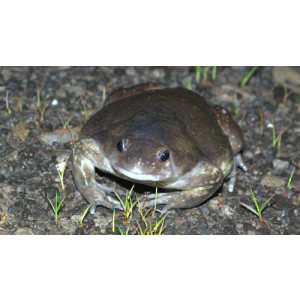Sri Lankan Painted Frog Did you see this animal?
Scientific Name : Kaloula taprobanica
Family : Microhylidae
Order : Anura
Class : Amphibia
Phylum : Chordata
Other Name : Sri Lankan Painted Frog, Sri Lankan Bullfrog
Habitat : Forests, Rural/Grasslands
Description : The Sri Lankan Painted Frog are typically found in the wet zone of the country, in areas such as rainforests, streams, and marshes.They require a moist environment to survive and are most commonly found in areas with high rainfall.
It has a distinctive appearance, with bright yellow, red, and black markings on its body. They are relatively small, growing up to 3 centimeters in length, and have smooth skin that is covered in glands that secrete toxins as a defense mechanism.
These frogs are nocturnal and are most active at night. During the day, they will usually hide under rocks or in leaf litter to avoid predators. They are carnivorous and will feed on a variety of insects, including ants, beetles, and spiders.
The Sri Lankan Painted Frog, like many other brightly colored frogs, is toxic to predators. The toxins they produce can cause illness or death in animals that try to eat them. However, they are not harmful to humans unless ingested in large quantities.
The breeding season for this frog occurs during the monsoon season, which lasts from May to September. Males will make a series of calls to attract females, and once they have paired up, they will lay their eggs in streams or other bodies of water. The tadpoles will then go through a metamorphosis into adult frogs.
The Sri Lankan Painted Frog is considered to be a critically endangered species due to habitat loss, pollution, and other threats. They are also at risk from a fungal disease called chytridiomycosis, which has decimated amphibian populations around the world.
It has a distinctive appearance, with bright yellow, red, and black markings on its body. They are relatively small, growing up to 3 centimeters in length, and have smooth skin that is covered in glands that secrete toxins as a defense mechanism.
These frogs are nocturnal and are most active at night. During the day, they will usually hide under rocks or in leaf litter to avoid predators. They are carnivorous and will feed on a variety of insects, including ants, beetles, and spiders.
The Sri Lankan Painted Frog, like many other brightly colored frogs, is toxic to predators. The toxins they produce can cause illness or death in animals that try to eat them. However, they are not harmful to humans unless ingested in large quantities.
The breeding season for this frog occurs during the monsoon season, which lasts from May to September. Males will make a series of calls to attract females, and once they have paired up, they will lay their eggs in streams or other bodies of water. The tadpoles will then go through a metamorphosis into adult frogs.
The Sri Lankan Painted Frog is considered to be a critically endangered species due to habitat loss, pollution, and other threats. They are also at risk from a fungal disease called chytridiomycosis, which has decimated amphibian populations around the world.
Distribution in Bangladesh
References:
description written by: Md. Shalauddin, Department of Zoology, Jagannath University, Dhaka. Information sources: IUCN Red List Bangladesh-2015, Hasan 2014, Khan 2018 (Photographic guide to the wildlife of Bangladesh).photo credit:aniruddha_singhamahapatra(www.inaturalist.org/people/aniruddha_singhamahapatra),photo copyright: iNaturalist. more information please contact with us.
description written by: Md. Shalauddin, Department of Zoology, Jagannath University, Dhaka. Information sources: IUCN Red List Bangladesh-2015, Hasan 2014, Khan 2018 (Photographic guide to the wildlife of Bangladesh).photo credit:aniruddha_singhamahapatra(www.inaturalist.org/people/aniruddha_singhamahapatra),photo copyright: iNaturalist. more information please contact with us.



















